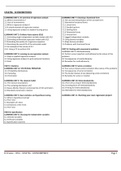Summary
ECS3706-Econometrics Summary Notes.
- Institution
- University Of South Africa
ECS3706-Econometrics Summary Notes. LEARNING UNIT 1: An overview of regression analysis 1.1 What is econometrics? 1.2 Uses of econometrics 1.3 What is regression analysis? 1.4 A simple example of regression analysis 1.5 Using regression analysis to explain housing prices LEARNING UNIT 2: Ordi...
[Show more]



